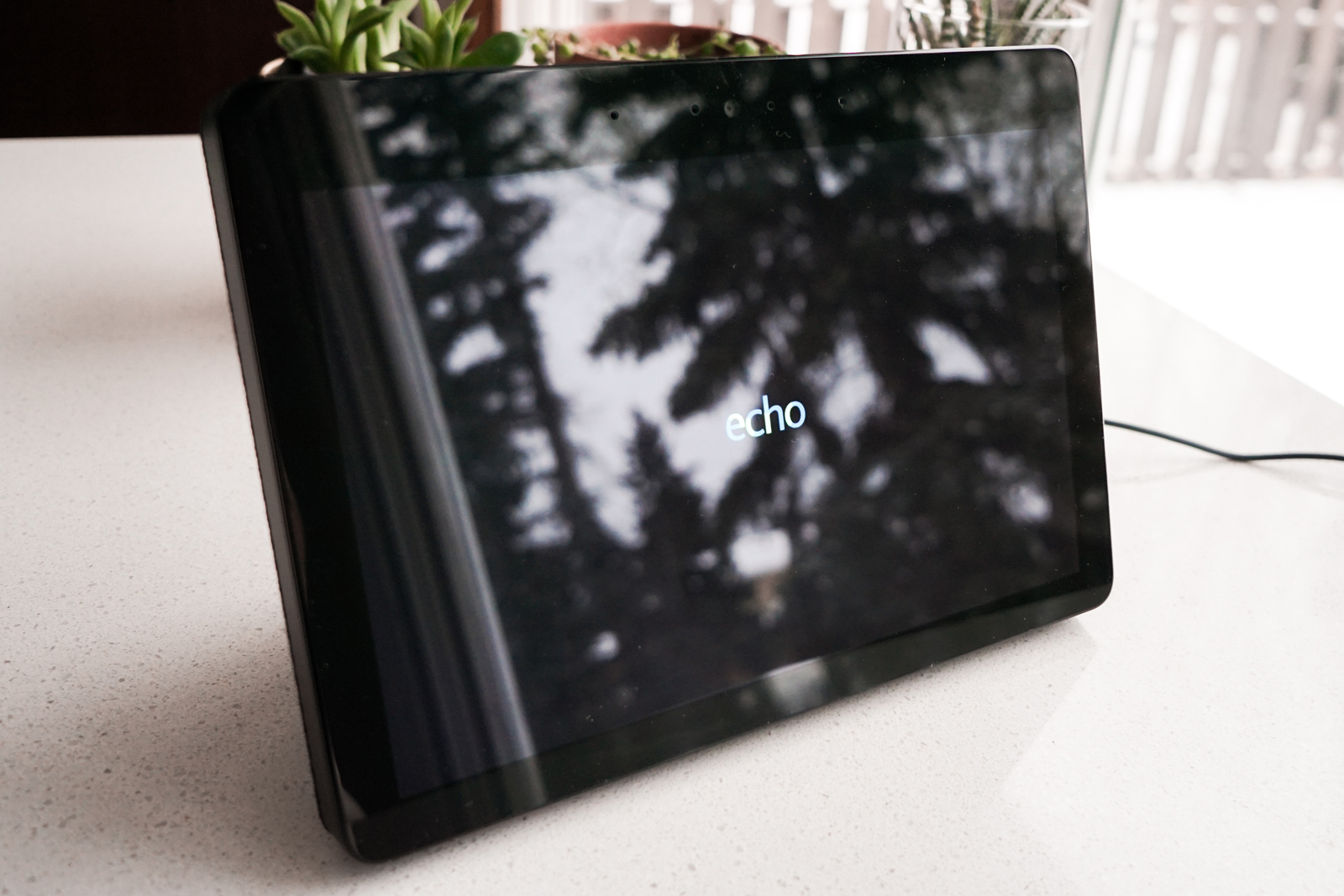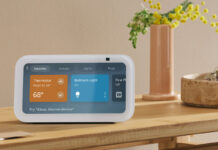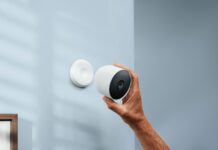
In my household, we call our Amazon device by its name: “Alexa”. It’s a first generation Amazon Echo Show; it lives with my grandmother; and it sits on top of her dresser so we can watch over her in case she has a fall or accidentally wraps herself up in a phone cord and can’t get out (again). My mom has it half-hiding in a fabric case, and it’s not uncommon to hear sentences like, “your grandmother called your aunt and uncle six times on Alexa this morning, and now he’s begging me to uninstall his number from her contacts list.”
We use our Amazon Echo Show solely for video calls, but it does a lot more than that. The new model featured here puts our barely-dated one to shame, and it looks crisp and all-encompassing on a side table. Instead of featuring a solid bottom half and a small screen up at the top (like ours does), the 2018 Echo Show is almost all screen.
And oh, what a gorgeous screen it is.
Amazon Echo Show: What’s in the Box?
This model of Echo Show has a 10.1″ HD touchscreen, fabric sides, and an inherent tilt. The box actually arrives pretty empty—tech is getting sleeker with fewer accessories and more universal parts.

The Echo Show comes with a charging cord and base, an instruction manual and factsheet, and that’s about it. (Well, the device is in there too.) Because it’s not a wireless product, you can start setting it up right out of the box without waiting for its battery to charge up.
Setup takes … a while. With all of the updates that the Amazon Echo Show 2nd Generation needed out of the box, setup took long enough that I got hungry and the sun set. I’d peg setup at about 40 minutes including tutorials and Alexa account setup, although I guarantee you that that amount of time will decrease if you have a faster internet connection. Mine’s been acting up recently, and I can’t figure out why, so my upload and download speeds are a little sluggish!
On top of the Echo Show are three buttons: two for volume, and one to mute the device’s listening capabilities. The latter looks like a circle with a line through it, and when depressed, it illuminates the symbol in red while displaying a red bar at the bottom of the screen where Alexa’s listening bar would usually pulse.
What Exactly is Alexa?
Amazon’s products run on Alexa, the mega-corp’s proprietary conversational artificial intelligence. It’s a weak AI—a reactive machine with a limited memory. The first thing to know about Alexa is that it isn’t going to gain sentience. Unlike the imaginary Skynet, which was canonically a fully self-aware AI with a complex theory of mind, Alexa operates more like Google than like a human. It parses trigger words, searches for terms, and uses algorithms to interpret input.
While Alexa might “learn” to respond to a different trigger word upon your selection, it won’t learn what love is, or how ageing works. Our Alexa responds to “computer” because my grandmother kept responding to Alexa’s female-typed voice by phrasing her commands as “Alexis, could you please…?”. Like an automated telephone system that can guide you through a menu, Alexa uses voice commands to deliver on its many features.

Amazon Echo Show Features
The Amazon Echo Show’s primary features are to allow you to make video calls and watch movies. With a built-in Zigbee hub, it also lets you connect to and vocally control your smart home devices. It’s larger and brighter than Echo Shows of years gone by, with a 10.1″ HD screen and premium stereo speakers with Dolby processing.
The Echo Show streams music, audiobooks, and podcasts with pre-loaded Amazon Music, Spotify, Radioplayer, and Deezer apps (subscriptions not included). It can video call any Echo Show, Echo Spot, or Alexa app, or allow you to Drop In on other Echo devices. You can even view a live feed from a camera (sold separately) to check up on your home or loved ones while you’re away.
The Amazon Echo Show 2nd Generation is available only with English language support, but its “skills” (Alexa’s voice-based apps) are expanding. It has eight microphones (and far-field technology) and can hear you even while you have music playing and are halfway across the kitchen.

Video Calling with the Amazon Echo Show 2nd Generation
I rely heavily on my smartphone, but I spend very little time using tablets. My reasoning is mostly out of laziness, if I’m being honest. I like how easy it is to see everything on a large, bright tablet-sized screen like this one, but I couldn’t bother to be tied down to one location. Even when tablets are wireless and portable, typing on their large face is considerably more cumbersome than typing on a smartphone.
So, when it comes to products like the Amazon Echo Show, I don’t think I get full use of all of their capabilities. I’m unlikely to ever play a recipe video while cooking, or ask a device to Google something for me that I could finish typing in the time it took me to say the device’s trigger word. But for video calling, Alexa is awesome—and easy.
The screen on the Amazon Echo Show is bright and clear. Its speakers sound great (way better than an iPad’s), and the microphone picks up my voice easily from the other side of the kitchen. I can continue to work on tasks or put together dinner while on a call using the Echo Show 2nd Generation, and the substantially larger screen size means that not only can my call companion hear me, but I can see them, too.

Graininess and loss of image quality are notable in poor lighting conditions, but the video stream quickly reboots itself when you turn it on and off. Once the sun dipped past the horizon as I was filming, I had some issues with the video stream turning black and white. Rebooting it corrected the problem immediately, with zero need for troubleshooting.
Drop Ins with the Amazon Echo Show
While it’s super easy to ask Alexa to make video calls for you on the Echo Show, I don’t actually think that that’s the only reason to consider one. Although it is a really great way to stay in touch, Alexa’s household capabilities enrich the user experience to a large degree. If you’re comfortable leaving its listening capabilities turned on, you’ll be able to control your smart home devices with only voice commands.
Once you add more users and devices to your household, you’ll also be able to “Drop In” on other family members. But for this to work, they have to enable this feature on their end, too! Alexa’s Drop In features allow you to check up on kids (in another playroom) or your parents if they live outside the home. My aunts and uncles all have the Amazon Alexa App on their phones, so my grandmother can video chat them throughout the day. They can also Drop In on her if they haven’t heard from her and are worried that she’s had a fall.

The quality of when I Drop In has always been on par with my video calls, and I appreciate the fact that it fuzzes out the video feed for the first few seconds. It’s nice that the system allows the Drop In recipient to put some pants on before the caller sees anything untoward. And, at least for my family, it’s really helped decrease how lonely my grandmother feels in her care home.
In Conclusion
I’ll leave you with this. If portability isn’t an issue, the Amazon Echo Show makes video calling easier than a standard tablet. The device itself is more stable than something in an aftermarket stand, and the audio quality is leagues better. Its smart home integration is tempting, and its ability to Drop In on family members who need more care makes the Amazon Echo Show a part of my family’s daily life.
Shop the Amazon Echo Show online at Best Buy today.



